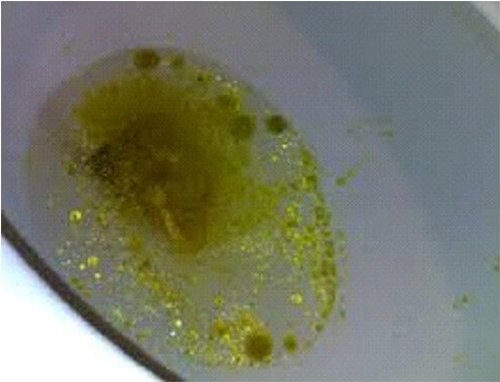Steatorrhea Definition
A human stool consists of different materials such as water, mucus, protein, fiber, salt, cell linings, bacteria, and fats.
Most of the content should be water and a little of everything mentioned above. If there is too much fat in the stool, the condition is called steatorrhea.
It is not really a medical condition but a clinical manifestation of a disease such as a malabsorption syndrome.
What causes fat in the stool? Are there any health implications? Keep on reading below. (1, 2, 3)
Steatorrhea Pictures

Image 1: The water inside the bowl has drops of oil, which is one of the symptoms of steatorrhea.
Photo Source: healthfixit.com

Picture 2: Lactose intolerance is one of the primary causes of too much fat in the feces.
Image Source: health.facty.com

Photo 3: Taking folic acid can actually help in the treatment, management, and prevention of steatorrhea.
Picture source: charlies-magazines.com
Causes of steatorrhea
- Digestive problem – Too much fat in the stool is an indicator that the digestive system has a hard time breaking down foods.
- Cystic fibrosis – It causes malabsorption leading to accumulation of fat in the stool.
- Pancreatitis – It is the inflammation of the pancreas. It is the organ that secretes enzymes, which is helpful in the digestion of protein, carbohydrates, and fats in the small intestine. (3)
- Lactose intolerance – the body lacks lactase, an enzyme used to digest the sugar in milk products.
- Biliary atresia – the duct that carries bile from the liver to the gallbladder has a blockage.
- Celiac disease – It is a condition in which a person has a sensitivity to gluten.
- Whipple disease – It is a type of bacterial infection affecting the body’s ability to break down carbohydrates and fats.
- Crohn’s disease – The gastrointestinal tract is inflamed. (4)
Steatorrhea symptoms
- The stool looks pale and bulky.
- The stool smells extremely foul.
- The stool tends to float because of high gas content.
- If you look at the water inside the bowl, you will notice drops of oil.
- The patient complains of indigestion and abdominal cramps.
- Loose stool and weight loss (3, 4, 5)
Steatorrhea diagnosis
If your stool is greasy and extremely foul, then you need to inform your doctor. The doctor will thoroughly assess your condition and will order various tests to accurately diagnose your condition. The number of fat globule in the stool sample will be measured.
The normal result should be less than 50 neutral fat globules and lower than a hundred fatty acid fat globules. Another way to test steatorrhea is collecting stool samples for at least four days and the amount of fat in the stool is checked every single day. A normal fat content should be around 2 to 7 grams/24 hours for adults.
That fat content should not be more than 20% of the solid stool sample. For infant’s stool, it should be less than 1 gram/24 hours. Breastfed babies’ stool must contain at least 10% to 40% of fat in the stool. On the other hand, bottle-fed babies usually have 30% to 50% fat in the stool. (2, 5, 6)
An abdominal x-ray, CT scan, and ultrasound can be ordered to check for pancreatic and small intestine diseases, which are the leading cause of too much fat in the stool. If the doctor suspects a small intestinal disease, the following diagnostic procedures are ordered:
- D-xylose absorption – It will test the function of the proximal small bowel. D-xylose is a type of sugar.
- Schilling tests (I and II) and bile acid breath tests – These tests will detect bacterial overgrowth.
- Barium study – It will help detect any abnormalities in the small bowel. (7)
Steatorrhea treatment
Treatment for steatorrhea is focused on treating the underlying cause. To come up with the most effective treatment, a reliable and accurate diagnosis should be made. The treatment modalities usually include the following:
- Diet modification – If too much fat in the stool is diet-related, the best remedy is to modify the diet. If you have lactose intolerance, you should avoid milk and dairy products. If you have a celiac disease, you should avoid foods containing wheat and gluten.
- Medications – If it is caused by an underlying medical condition, then it should be treated using the right medication. The primary cause of too much fat in the stool should be addressed first. For an instance, a patient suffering from chronic pancreatitis should take potent enzymes (pancreatic enzyme replacement). It helps reduce the passage of bulky stools. (5, 8, 9)
What can you do to prevent steatorrhea?
Some of the causes of steatorrhea are due to human lifestyles such as too much fat in the diet and nutritional deficiencies. Hence, it is important to take good care of the body. If you are the type of person who loves to eat fatty foods, then you should cut back the portion of what you eat.
Always make it a habit to check the nutritional label when shopping for foods. If you are deficient in certain nutrients, then you should take nutritional supplements. They are available at the leading stores.
Steatorrhea can be short-term or long-term. If steatorrhea is short-term, then it is most likely due to diet or GI infection. However, if you continue to notice too much fat in your stool, it could be an indicator of a serious underlying condition. Therefore, it is important to consult your doctor the soonest time possible. (2, 5, 7, 8)
References:
- https://en.wikipedia.org/wiki/Steatorrhea
- https://www.healthline.com/health/steatorrhea
- https://www.diagnose-me.com/symptoms-of/steatorrhea.php
- https://www.healthgrades.com/symptoms/steatorrhea
- http://healthfixit.com/steatorrhea/
- http://www.primehealthchannel.com/steatorrhea-pictures-definition-symptoms-causes-and-treatment.html
- http://pathwaymedicine.org/steatorrhea
- https://www.belmarrahealth.com/floating-poop-steatorrhea-understand-why-your-stool-floats/
- https://medicalfoxx.com/steatorrhea.html
- https://www.medigoo.com/articles/steatorrhea/
